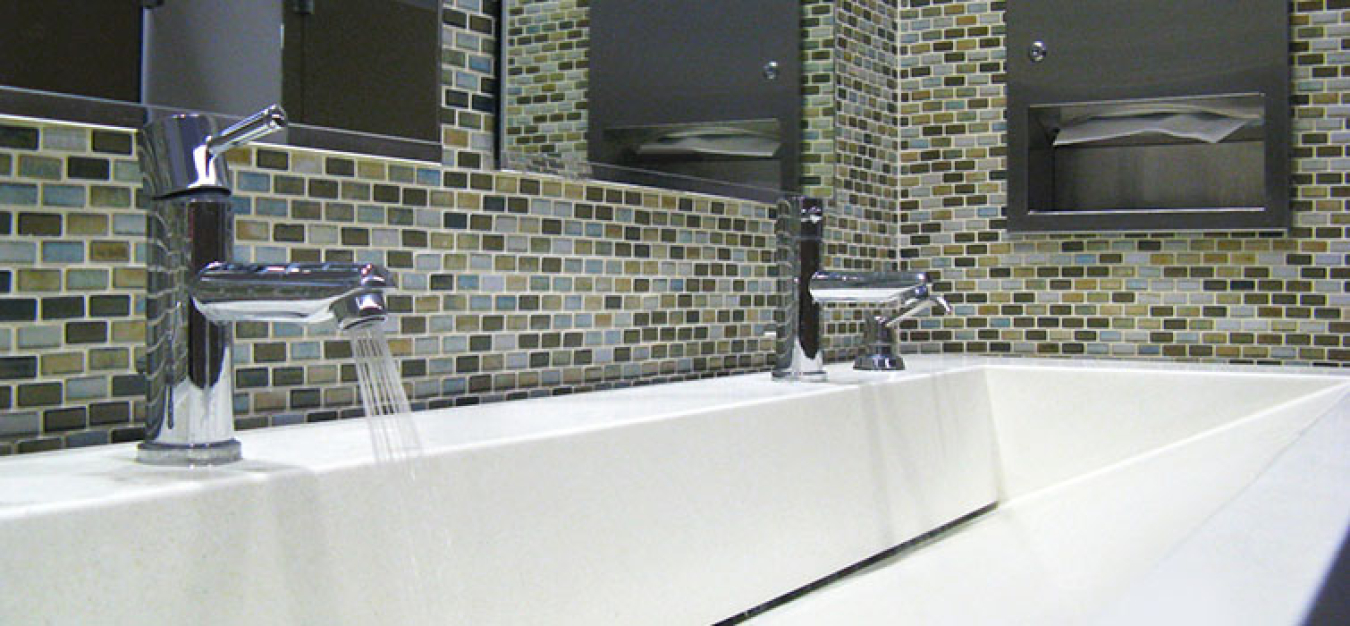
Most federal buildings have faucets in restrooms, kitchens, and laboratories. Many federal installations have showers, including barracks, family housing, recreation facilities, and locker rooms. Significant opportunity for water and energy savings exists for these fixtures when upgrading to efficient technology and employing conservation practices.
Overview
Federal standards mandate that all lavatory (bathroom/restroom) and kitchen faucets and faucet aerators manufactured and sold in the United States after January 1, 1994, must use no more than 2.2 gallons per minute (gpm). In addition, metering faucets (those that, when activated, dispense a predetermined volume of water) must discharge no more than 0.25 gallons per cycle (gpc). Federal standards also mandate that all showerheads manufactured and sold in the United States after January 1, 1994, must use no more than 2.5 gpm. These fixtures are often referred to as “low flow”. However this is a misnomer. These fixture ratings are the maximum flow rate allowed! The term for fixtures that are more efficient than the federal standard are called "high efficiency".
High-efficiency faucets and showerheads are available in the marketplace. The U.S. Environmental Protection Agency (EPA) WaterSense Program released a specification for residential bathroom lavatory faucets and faucet accessories (e.g., aerators and laminar devices) requiring a maximum flow rate of 1.5 gpm or less, a 32% decrease in flow rate over the federal standard. Only lavatory faucets intended for private use (i.e., residential housing, barracks, and other dwelling units such as hotel guest rooms and hospital rooms) are eligible for the WaterSense label.
To address lavatory faucets intended for public use, the American Society of Mechanical Engineers A112.18.1/Canadian Standards Association B125.1 Plumbing Supply Fittings specifies that public lavatory faucets (all faucets other than those defined as private), other than metering, must have a maximum flow rate of 0.5 gpm.
WaterSense released a specification for showerheads requiring a maximum flow rate of no higher than 2 gpm. The WaterSense specification for showerheads also includes performance requirements. All WaterSense-labeled showerheads must meet minimum spray force and coverage specifications.
Federal sites should purchase WaterSense-labeled plumbing products for all new construction and renovation projects.
Operations and Maintenance
To maintain water efficiency in operations and maintenance, federal agencies should do the following.
- Establish a user-friendly method to report leaks and fix them immediately.
- Encourage cleaning or custodial crews to report problems.
- Test system pressure to make sure it is between 20 and 80 psi. If the pressure is too low, high-efficiency devices won't work properly. If it is too high, they will consume more than their rated amount of water.
- Install expansion tanks and pressure reducing valves and reduce water heater settings where appropriate to prevent temperature and pressure-relief valves from discharging water.
- Correctly adjust and maintain automatic sensors on faucets to ensure proper operation. Sensors must be calibrated to ensure water use only when washing hands and not be triggered by users passing in front of the faucet.
- Encourage users to take shorter showers. Place clocks or timers in or near showers to allow users to track their timing better.
- Post energy/water awareness information to encourage efficiency from users.
Retrofit and Replacement Options
The following retrofit and replacement options help federal agencies maintain water efficiency across facilities.
- When installing new showerheads, for new construction, major renovation, and fixture replacement, choose models with a WaterSense label, which have flow rates no higher than 2 gpm. Verify that the hot and cold water plumbing lines are routed through an auto-compensating mixing valve (either thermostatic or pressure balancing) designed for the flow rate of the showerhead. This valve prevents significant fluctuations in water pressure and temperature if designed for the flow rate of the showerhead and can reduce risks of thermal shock and scalding. Check with a local plumber and, if necessary, install an auto-compensating mixing valve designed for the flow rate of the showerhead you plan to install.
- For kitchen faucet retrofits, install aerators or laminar flow devices that achieve a flow rate of 2.2 gpm, consider installing a flow rate of 1.5 gpm to maximize savings.
- For lavatory faucet retrofits in public restrooms, install faucets or faucet aerators or laminar flow devices that achieve 0.5 gpm flow rate, required by plumbing codes.
- For lavatory faucet retrofits in private restrooms (residential housing, barracks, hotel guest rooms, and hospital rooms), install WaterSense-labeled high-efficiency lavatory faucets, faucet aerators, or laminar flow devices with a maximum flow rate of 1.5 gpm.
- Install temporary shut-off or foot-operated valves with kitchen faucets. These valves cut off the water flow during intermittent activities such as scrubbing or dishwashing. The water can be reactivated at the previous temperature without the need to remix the hot and cold water.
- Automatic sensors on "touchless" faucets are not considered conservation devices. Studies have shown that automatic sensored faucets can waste water because they can be triggered when not needed by the occupant and flow at the maximum flow instead of partial flow, which is more common for manually operated faucets. See the study on the Alliance for Water Efficiency.
For more information, see EPA's WaterSense at Work BMPs for faucets and showerheads, the Alliance for Water Efficiency's faucet fixtures introduction, and EPA's WaterSense Rebate Finder.

